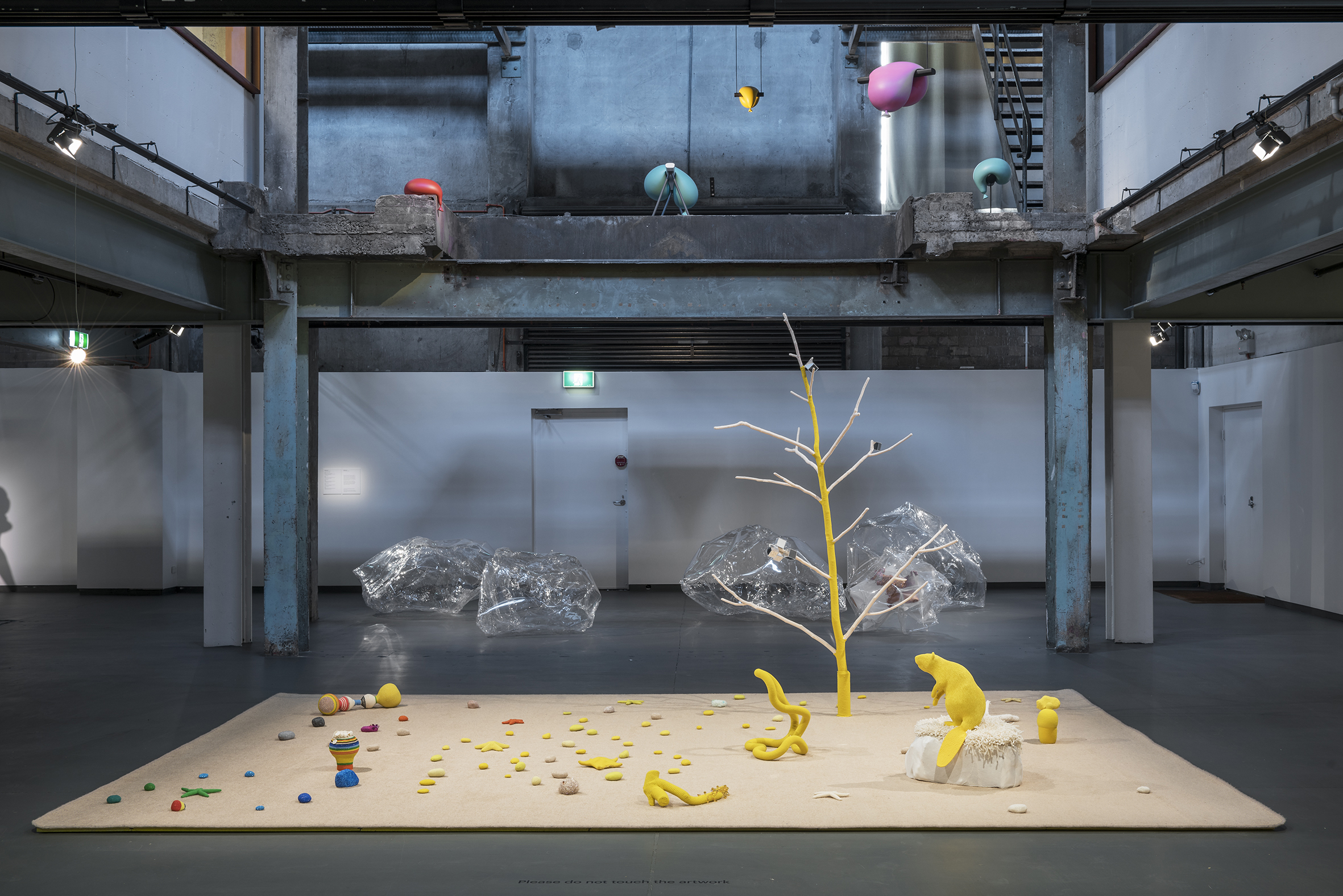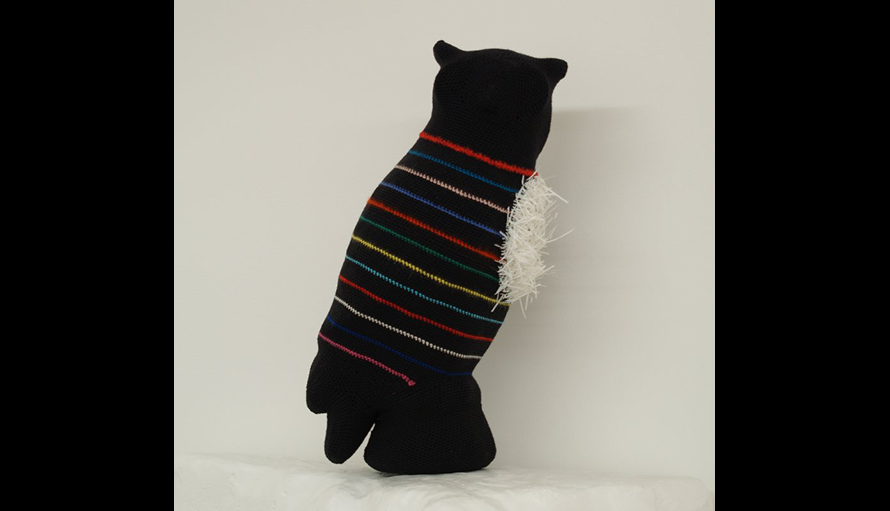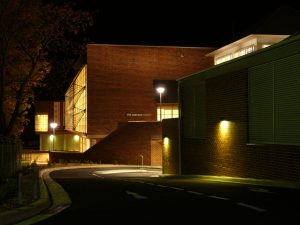SHOWCASE highlights the contemporary artists and curators we work with and whose work you will see in galleries and museums across NSW and beyond in the near future.
Louise Weaver uses hand–crotched lambswool, embroidered thread, Japanese silks and Swarovski crystals to reimagine the poetic possibilities of nature in her unique Technicolor brilliance. Her tactile inventiveness is evident in the luxurious menagerie of creatures and objects featured in her work.
Born in Mansfield, Victoria in 1966, Louise Weaver has exhibited widely since the early 1990s. Exhibitions include Sugar Spin: You, Me and Everything, Queensland Art Gallery | Gallery of Modern Art (2016-2017), Human/Animal/Artist, McClelland Sculpture Park + Gallery (2016), Animate/Inanimate, Tarra Warra Museum of Art (2013), Before and After Science Adelaide Biennial of Australian Art, Art Gallery of South Australia (2010) and Almanac, the Gift of Ann Lewis AO, Museum of Contemporary Art (2010).
Her work is held in many significant public and private collections including the British Museum, Art Gallery of New South Wales, Queensland Art Gallery | Gallery of Modern Art, National Gallery of Victoria, Museum of Contemporary Art, National Gallery of Australia and Monash University Collection among others.
Rachel Arndt, M&G NSW’s Gallery Programs and Touring Exhibitions Manager spoke with Louise Weaver about her work in Soft Core, on at Hawkesbury Regional Gallery from 30 March – 14 May 2017 and touring to 11 galleries in NSW, QLD and VIC with thanks to the Federal Government’s Visions of Australia program.
RA: Your work, no small wonder (2005) in the Soft Core exhibition, like much of your previous work, features animals in fantastical environments or contexts. What interests you about animals and their ‘habitats’?
For more than 20 years my art practice has been primarily concerned with concepts of nature and its representation, its fragility and endurance, evoking nature’s boundless capacity for continual reinvention and rejuvenation. Animal, plant, found and constructed abstract forms have been customized and created as both unique works and as components of larger installations. Ideas such as camouflage, transformation, metamorphosis; the destruction of existing natural habitats and resulting decrease in biodiversity inform this work.
In the carpet based work, no small wonder (2005) forms and structures observed in nature are reimagined, subverted and represented as symbolic metaphor – A beaver sits on a “mossy” outcrop, examining “treasure” deposited by rising tide – natural and industrial forms conjoined through the forces of nature and passage of time. Recovered and re-covered they are dispersed as remnant leavings, an optimistic gesture of protection and hope.
RA: Not only are your animals situated within fantasy environments but they are also tightly wrapped in hand crocheted or stitched ‘skins’. Is this a form of luxurious armour or camouflage against the created elements?
I often construct complex and delicate crochet and embroidery “sheaths” over such diverse objects as taxidermy models, found objects and constructed forms. Natural and synthetic fibres are crocheted (grafted) onto these “hosts” directly to create a metaphoric new skin or semi-permeable membrane. This process simultaneously conceals and reveals aspects of the objects underlying structures suggesting transformation at every level in realms that incorporate the real and imaginary, nature and culture.
These surface coverings are further ornamented with a variety of media. The colours, patterns and depth of ornamentation often refer symbolically to the natural world – where colour is used to camouflage, attract, or to signify danger.
RA: What interests you in traditional craft techniques such as crochet, weaving, embroidery and sewing?
Since the late 1980’s I have produced installations, sculpture, paintings, drawings, prints, multiples, ceramics, glass, photographs, digital and sound work. I love trialing ideas and testing materials – seeing how their properties may be extended and implemented in new often-unexpected ways – often lavishing inexpensive materials with the most loving care and attention. My early experiments with techniques often associated with (gendered) craft practices have led to the development of an extensive body of work. Textiles and in particular their relationship to the fine art object has been a particular focus for my studio research.
Early sculptures such as I am transforming an antler into a piece of coral by crocheting over its entire surface (1994), Invisible Bird (1997), Blue Tulip (1998) – titled descriptively (with dead-pan humour) or poetically, deploying Surrealist strategies of wordplay, inscribe further layers of (environmental and feminist) content. These works conceptually and materially preempt the development of ambitious floor based sculptural installations including no small wonder. I also deploy craft techniques such as crochet and embroidery to mimic the visual appearance of phenomena observed in the natural world, such as the refraction of light through a dewdrop or the crystalline structure of a snowflake. In all cases the ideas I wish to express determine the techniques and materials I select.
RA: You have talked in the past about the visual object or assemblage as creating a sense of space and a narrative device for revealing the unfolding of time. Why is the passage of time important?
Time is highlighted in my practice as both necessary for making an artwork and apprehending it in completion – an experience of intense delight that is unfolding and sustained. The system of crochet and embroidery I employ to cover forms; marks out territory; inscribes terrain – it acknowledges an obsessive compulsion to fill with detail (Horror vacui). It is performative (bodily) and sensorial and expresses the often-urgent desire to create (“fill in time”).
Sound is also integral to many of my works; it creates mood, triggers memory and is temporal. The sound I use is personal and often quite intuitive; sounds are sometimes sampled from recordings I have listened to throughout my life, adjusted, distorted and reconfigured or may be formally composed or improvised and played by my friends or myself, or field recordings of natural sounds that relate to the visual component of my work.
Throughout my life I have examined at first hand objects in museum collections in Australia and around the world. Originally and at an early age I was interested in the technical aspects of the “making of things”. As I have continued to research these objects, the spiritual, Shamanistic, animistic, and conceptual meanings, embellished by mythology, legend, their formal and spiritual functions have become elements of particular significance for my work – in that these objects may fluctuate with formal and mystic or otherworldly concerns, which have bearing on the reality of our existence. I am particularly fascinated in the ways combinations of materials; patterns and sensory experiences may enable psychological and physical removes from a present location or time, reanimating the artwork/ space with fantasy, imagination and even the paranormal.
RA: Where can we see your work next?
Sugar Spin: You, Me and Everything, Queensland Art Gallery | Gallery of Modern Art, Brisbane, Queensland. Currently showing – until 17/04/2017 curated by Geraldine Barlow
Collective vision: 130 years, Bendigo Art Gallery, Bendigo, Victoria. Currently showing – until 28 May 2017
I will also exhibit a body of new work at Darren Knight Gallery, Sydney, NSW later in the year.
An exhibition curated by Micheal Do, in conjunction with Casula Powerhouse Arts Centre and toured by Museums & Galleries of NSW. This project has been assisted by the Australian Government’s Visions of Australia program.







